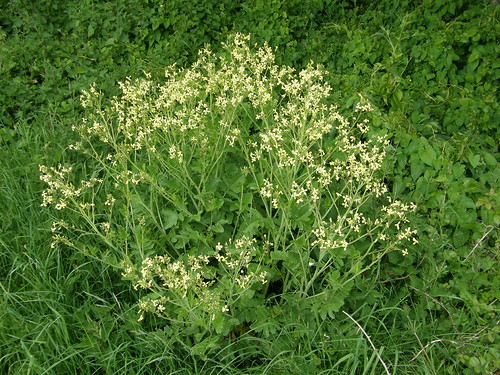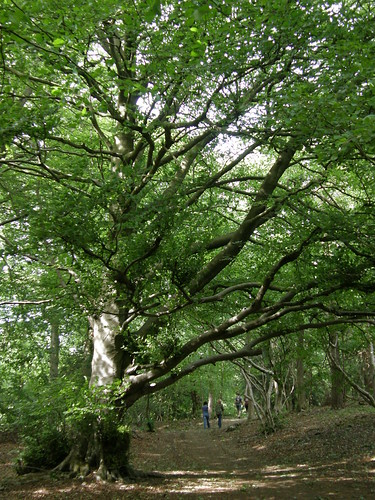Last night it was already late when I set out for a walk. With overcast skies, even the astonishing capability of my new camera to conjure light out of the gloom was defeated. But there were so many images that I wanted to record.
In Townsfield, across the road, there were cows and calves and a muscular bull. In the hedge here I was struck by the multi-coloured hues of the new oak leaves. Down at the Cove the silvery leaves of a Whitebeam growing out of the cliff face demanded attention, and the Lots were a pointillist masterpiece of many coloured meadow flowers including another fine collection of Orchid spikes.
So when I arrived home in bright sunshine to find that Angela had taken the children to a friends for their tea I decided to retrace my steps. It even occurred to me that I might attempt to recreate the journey by taking exactly the same photos again, although hard on the heels of that thought came the realisation that I was destined to fail in that task, since on of the photos I took last night, of a flickering light out in the Bay which was presumably the flare from an oil platform, needed the darkness that otherwise frustrated my efforts.
And anyway, the Bull and his harem were lying down today. In this position he looked affable and benign, not at all the epitome of brute force and muscular power that he appeared to be last night.

And of course, this being a new day and not some sort of Groundhog Day rerun, I was always likely to notice different things, like these Elderflowers which must have just recently opened:

The oak leaves were still there in the hedge:

After the grandeur of the huge trees at Levens Park, and its large mammalian inhabitants, today’s photography was mostly More Fun with a Macro Lens.

The hedge along the far side of Townsfield is a very young hedge, planted with a selection of shrubs and trees. Walking beside it I was struck by the incredible variety of forms and textures of the different leaves.

The Lime leaves and the Hazel leaves are similar in size and shape, and yet the downy, fractal bordered Hazel leaves are quite distinctively different from the Limes.

New Hawthorn leaves are apple red/green, and new Ash leaves almost purple:

But soon turning green:

Naturally, there were many flowers along the path too. I think that this might be some sort of Dock, but in my books none of the Docks look this ethereal and pretty:

This is Ivy-Leaved Toadflax, a naturalised species with tiny flowers which covers many of the garden walls in the village:

This Bumble Bee was clearly keen on vetch nectar:

The back of the cove was decked out with what I think might be Sea Radish, although I’m not at all sure:


Stooping to photograph the deeply-lobed leaves,for identification purposes, I noticed that the plant was liberally festooned with small snails:


There’s something deeply appealing about spirals and their occurrence in nature. And they are everywhere. In Pineapples and Seashells, distant nebulae, DNA.
Our house is slowly filling up with unread books that I have picked up, often for a few pence at the weekly Coffee Morning in the village. On top of these physical piles of books are the mental lists of Books To Read. A long standing obligation on that list is ‘On Growth and Form’ by D’Arcy Wentworth Thompson. Published in 1917 it was ahead of its time in attempting to examine the geometry of nature before the invention (or discovery) of fractals.
My attempt to photograph the Whitebeam leaves was partially foiled…

by the light behind:

Once again my camera was more observant than me and noticed the tiny fly on these Herb Robert flowers:

If I ever tire of flower photos, I could always switch over to seed heads…

… like this Honesty.
Or grasses:

Although curiously, my camera seems to be temperamental when it comes to grasses and for the most part refused to focus on the seed heads.
A repeated trilling form the trees beside me had me looking up for its source and when I heard a squawk, saw a flicker of wings and then found this perfect hole in a tree trunk…

…my first thought was of Woodpeckers. Probably because I had a fantastic view of a male Great Spotted Woodpecker through a window during a meeting yesterday. I wasn’t daydreaming whilst the meeting carried on without my attention – I interrupted the conversation and made everyone else watch too.
I assume that this was at one time a Woodpecker nesting site, but it is now occupied by a family of Starlings. Whilst I stood beneath the tree, both parents flew back and forth across the Lots, calling to their brood as the neared the nest.

FOOOOOOOD!!!

Here.

MOOOOOOORE!

Here.
It was constant work and looked exhausting. Perhaps they are rewarded with the same irrational pride as us: first primaries, first faltering flight…
Having stopped to watch the Starlings, I also noticed these keys on the Ash tree that was their home:

It seems astonishing that the recent delicate flowers can have so quickly become such abundant seeds.
The Lots were Pollocked with colour:

Chiefly from Buttercups:

But I was most drawn by the Orchids.

This is National Trust land, and somebody had helpfully erected an information sign about the Orchids. Apparently they are a mixture of Early Purple Orchids and Green Winged Orchids. I found it very difficult to distinguish between the two. I’m sure that this is an Early Purple:

And I think that these might be Green Winged:


But if anybody can confirm or deny please do.
In amongst the Orchids were some Bird’s-Foot Trefoil:

And in the next field some neatly symmetrical flowers of the parsley family that I will try to identify at some point:

And the end of the Lots I turned to look back at the views:


Before heading for home.
————————————————————————————————————-
Angela tells me that she and Amy watched a Blue Tit today as it repeatedly returned to a spider’s web to filch flies. She also directed me back into the shady part of the lane to find this Dryad’s Saddle, which I must have walked past a couple of times without noticing.


























































































































